Big Guns
by VividLight Staff
|
Price
Comparison |
| Minolta |
$4,000 |
| Nikon |
$4,600 |
| Sigma |
$2,200 |
| Tokina |
$2,200 |
For the first part of our ongoing pro series, we shot the X Games in
Philadelphia using several 300mm f2.8 pro lenses. So how did those
lenses stack up when we put them to the test?
Overall
Every lens has strengths and weaknesses that make it better suited for
some kinds of photography than for others. Given the price and
professional status claimed by all of these lenses our expectations were
high. At a minimum they should be rugged, well built, and produce
painfully sharp images; and they should render those images with
good color and contrast.
All in all each of the lenses here lived up to those expectations.
This we expected. Lenses don't last very long in the pro category
unless they live up to these basic requirements. We were a bit
surprised though at just how different the personalities of these lenses
turned out to be, and were particularly surprised at how significant an
edge one lens had in focus speed. All these lenses feature low
dispersion glass to improve edge sharpness and improve color saturation.
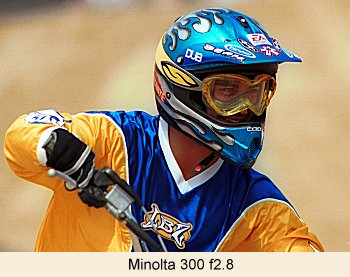
Our one disappointment was that Canon was unable to provide us with a
lens in time for this test. It would have been interesting to see
how it fared in this group.
Initial impressions.
A sit down on the patio to get familiar with the lenses prior to the
games put the Sigma and Tokina in the top spots ahead of the Nikon and
Minolta, both of which felt heavier and therefore harder to handhold at
lower shutter speeds. The Minolta in particular felt very front heavy. A
nod went to the Nikon for being the fastest to focus by a significant
margin and also for having the closest focus distance. Our conversation
obviously went to the price difference between the Sigma and Tokina vs.
the Nikon and Minolta. Another thing that stood out about the
Nikon was the size of it's monster carbon fiber lens hood. With
the hood mounted the lens increased in size by almost a
third.
The apparently better balance of these two
lenses and their lower price made them appealing choices.
Would their image quality rival that of the OEM's (Minolta and Nikon)? If so, then how could
anyone justify spending the big bucks (double) for the OEM lenses?
As a side note, we felt the Nikon had the only case that was really
usable in the field. The Minolta came in a robust hard case that would
do well in shipping. The Tokina came a faux leather case more suited to
storage than field use and the Sigma came in a plain green barrel case
made of abrasion resistant fabric. However it was just a plain barrel
with no provision for a body, film, or a real shoulder strap.
The Nikon case looked like something you'd pay several hundred dollars
for from Tamrac or Lowepro. It featured a padded shoulder strap with a
stitched Nikon logo, a heavily padded barrel bag made from water and
abrasion resistant material that could hold the lens (with hood
reversed) with a camera body plus side pockets for film and filters. The
bottom has thick rubber feet. The lens is accessed by unsnapping four
quick release snaps, then pulling down a double zipper that opens one
side of the case. Removable internal pads secured by hook and loop
strips allow you to configure the case to fit snugly with just a lens or
to hold a lens/body combo. While the case the lens comes in isn't
going to make up your mind about which lens to purchase, it was
definitely a nice feature.
We also noticed that the Sigma had apparently seen a lot of hard
press duty and it appeared that it may have been repaired at one time.
How We Tested
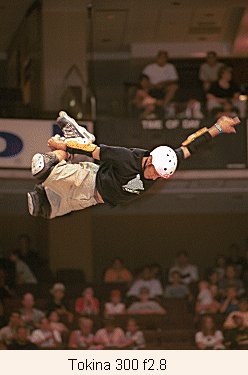 We tested during the X-games in Philadelphia. This was not static test
on tripods, it was an active fast moving shoot during events such as
Moto-X (motorcycle stunt jumping), bicycle stunt riding, skateboarding,
in-line skating, and speed climbing (fake rock wall).
We tested during the X-games in Philadelphia. This was not static test
on tripods, it was an active fast moving shoot during events such as
Moto-X (motorcycle stunt jumping), bicycle stunt riding, skateboarding,
in-line skating, and speed climbing (fake rock wall).
To eliminate as many variables as possible in a test like this, three of
the four lenses were the same lens mount, in this case Nikon, because
that's what the manufacturers had available for consignment at the time.
A photo assistant kept strict logs of who was shooting what and when on
a frame by frame basis so we could compare the images when they came
back from the lab. Most editors use a 4x or 8x loupe when reviewing
slides for publication, we used those plus a Peak 35x loupe to look at
things like edge sharpness with a critical eye. Why bother if editors
don't hold images to that standard? Simple, higher quality images
will have more pop. Sometimes it's not obvious why you like one
image more than another - but when you explore the details it becomes
obvious.
We processed film daily and reviewed the results while the
impressions of each lens were fresh in our minds. One thing this
process made obvious was that much of this type of shooting is timing.
Our constantly switching equipment for evaluation made it difficult to
get our timing down. We'd get better performance out of any of
these lenses if we were using them every day and had the opportunity to
learn their quirks and timing requirements.
In the Field
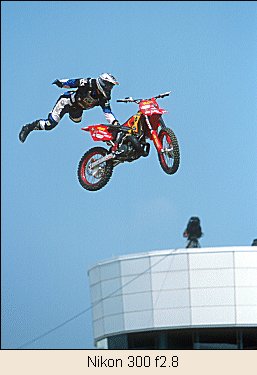 We expected to see differences between lenses, but were shocked at how
different they felt and performed when we were shooting side by side.
We expected to see differences between lenses, but were shocked at how
different they felt and performed when we were shooting side by side.
First, all of these lenses are HEAVY. No surprise there.
The surprise is how quickly you can get dialed in to shooting them
handheld. These are all big honking lenses and all of them feature
big tripod mounts for that reason. But when shooting fast action
sports, forget the tripod. This is where balance comes in and
after shooting for eight or ten hours straight you form some definite
opinions. We were surprised that in use, the Nikon that had felt a
little off balance on the back patio seemed to have the best balance,
followed closely by the Tokina, then the Sigma. In use, the
Minolta definitely felt front heavy and required a bit of a different
grip to get steady shots. But we were using a Maxxum 7.
Having the heavier Maxxum 9 would have improved the balance.
The Nikon that had appeared to be a bit faster than the others when
we were taking our time and getting acquainted, turned into a speed
demon when tracking fast moving motorcycles and skateboarders flying
through the air. No other lens came close to its ability to focus
quickly and smoothly. When using focus tracking for moving subjects it's
silent wave motor flowed smoothly keeping the subject in tight focus -
something that the Tokina and Sigma (both Nikon mounts) weren't always
able to do. Another surprise was how absolutely QUIET the Nikon lens is.
It was almost impossible to hear this lens focus over the ambient crowd
noise - something that couldn't be said for any of the other lenses
here.
While quiet may not seem like a big deal for a photographer in a big
sports arena, the Sigma had showed us the other extreme. The Sigma
focused with a noticeable mechanical sound. During focus tracking you
could sometimes hear an audible "thunking" as the lens
adjusted quickly in and out to pan with your subject. Perception is
important, and the audible difference led to a feeling of quiet
confidence in the Nikon and an uncertainty with the Sigma of "did I
get the shot?", or "the lens was hunting - I hope I got the
image..". In reality the Sigma probably wasn't hunting any more
than the Nikon during tracking, but the audible mechanical noises made
it seem as though it was. When we got to the light table we found
the Sigma had indeed gotten those images.
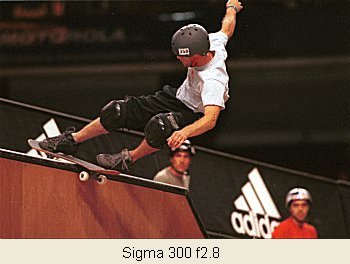 Returning to the subject of speed, the Tokina, while noticeably slower
than the Nikon, was number two in the speed lineup. When you acquired
the subject it would pull it in quickly, and the focus speed was fast
enough that it could usually stay with these fast and erratic subjects.
But while the Nikon could allow you to fire at the peak moment the
Tokina required you to lead that moment just slightly so it was locking
on at the right moment. The Sigma kept falling behind and we flat
missed some shots as a result. Its slower focus meant that at times it
would lose a subject and the focus system had to play catch up. As a
result we found we had to have an even longer lead that required us to
be more dialed in to locking in and firing at just the right moment.
Returning to the subject of speed, the Tokina, while noticeably slower
than the Nikon, was number two in the speed lineup. When you acquired
the subject it would pull it in quickly, and the focus speed was fast
enough that it could usually stay with these fast and erratic subjects.
But while the Nikon could allow you to fire at the peak moment the
Tokina required you to lead that moment just slightly so it was locking
on at the right moment. The Sigma kept falling behind and we flat
missed some shots as a result. Its slower focus meant that at times it
would lose a subject and the focus system had to play catch up. As a
result we found we had to have an even longer lead that required us to
be more dialed in to locking in and firing at just the right moment.
We were surprised the Minolta turned in the worst speed performance of
this bunch. The lens was the slowest focus and we missed shots as it was
trying to zoom into the subject. Compounding the situation were two
quirks that showed up in the Maxxum 7's focusing system.
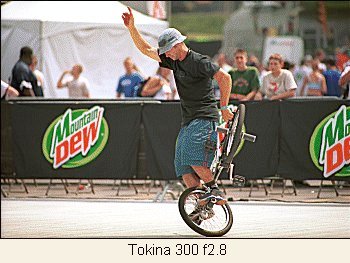 During the Moto-X event we were situated at the far side of the pit.
This meant the riders would be invisible to us until they flew off of
one of several hills arrayed in front of us. We were blind as to
when a rider was coming or where he was coming from until he was in the
air. This gave us only an instant to pick up the rider as he was getting
off of his motorcycle in mid-air before he re-mounted for his landing.
We tried pre-focusing the Minolta on one of the hilltops thinking that
if the lens didn't have as far to focus, it would pick up the rider
faster. But instead of picking up the rider near it's plane of focus,
the focus system would drive the lens back towards close focus, then
back out to finally acquire the rider - who had by then completed his
acrobatics and was back on the bike about to land. Adjusting the focus
limit on the lens helped, but we still had to really anticipate the
rider, and where he would be coming from so the system had time to
acquire the rider and drive the lens to it's correct focus point and
hopefully get the shot. This meant we got a lot of images just after the
peak moment because the lens wasn't keeping up. We had similar results
indoors during the skateboard events. During the Moto-X event we were situated at the far side of the pit.
This meant the riders would be invisible to us until they flew off of
one of several hills arrayed in front of us. We were blind as to
when a rider was coming or where he was coming from until he was in the
air. This gave us only an instant to pick up the rider as he was getting
off of his motorcycle in mid-air before he re-mounted for his landing.
We tried pre-focusing the Minolta on one of the hilltops thinking that
if the lens didn't have as far to focus, it would pick up the rider
faster. But instead of picking up the rider near it's plane of focus,
the focus system would drive the lens back towards close focus, then
back out to finally acquire the rider - who had by then completed his
acrobatics and was back on the bike about to land. Adjusting the focus
limit on the lens helped, but we still had to really anticipate the
rider, and where he would be coming from so the system had time to
acquire the rider and drive the lens to it's correct focus point and
hopefully get the shot. This meant we got a lot of images just after the
peak moment because the lens wasn't keeping up. We had similar results
indoors during the skateboard events.
Another frustrating problem with the Minolta system was it's inability
to maintain focus tracking when a subject moved past a stationary
subject. As riders raced past ramps, the camera would lose the
subject and
have difficulty reestablishing focus on the other side. A pleasant
surprise though was the fact that the lens captured sharp images even
though our last viewfinder image before the shutter clicked had been a
bit blurred. The camera was still driving the lens even
as the shutter was tripping.
Image Quality
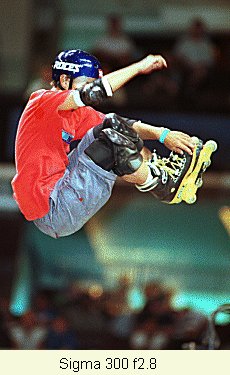 As we mentioned above, the image quality on all of these lenses was
excellent. The one area where we noticed a definite difference
however was in light fall-off when shooting wide open against a blue
sky. The Tokina showed light fall-off in the corners when shooting
Moto X riders wide open against a clear sky. The light fall off
was serious enough to require some cropping to make the images usable. It was the only lens that exhibited this
flaw.
As we mentioned above, the image quality on all of these lenses was
excellent. The one area where we noticed a definite difference
however was in light fall-off when shooting wide open against a blue
sky. The Tokina showed light fall-off in the corners when shooting
Moto X riders wide open against a clear sky. The light fall off
was serious enough to require some cropping to make the images usable. It was the only lens that exhibited this
flaw.
What really surprised us though was the significant edge that went to
the Nikon when it came to generating keepers. We had liked it's
fast focus and balance in use but we weren't prepared for the
significant edge it would pile up when the china markers came out at the
light table. We went through all the slides and negs with a
quality loupe marking those that we thought met the criteria of
"magazine quality." When we were finished, the Tokina,
Sigma, and Minolta all had comparable ratios of shots taken to keepers.
The Nikon beat them all by a factor of 4 to 1.
The reason this was so much of a surprise was that initial tripod
mounted test shots hadn't shown a huge edge in image quality.
Credit that fast auto-focus that allowed us to get shots that we
"just missed" with the other lenses.
Opinion
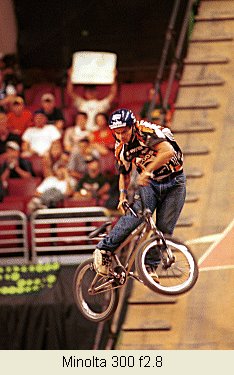 By the end of the games one thing was obvious: when a top athlete was
coming up that we knew would provide great action, we reached for the
Nikon - hands down and without question or hesitation. If we were making
our living as sports shooters this is the lens we would have without
question or hesitation - price be damned. These guys have to come back
with the shot, period, no excuses. For them the $2,400 price difference
is a one-time equipment cost for a lens they'll have for years. When it
comes time to trade the lens in on a new one, the Nikon has the highest
value on the used market; a fact that cuts deeply into that $2,400 price
difference. Our opinion was borne out by the fact that this single lens
was seen on the cameras of the large majority of shooters covering this
event with only a sprinkling of other lenses present.
By the end of the games one thing was obvious: when a top athlete was
coming up that we knew would provide great action, we reached for the
Nikon - hands down and without question or hesitation. If we were making
our living as sports shooters this is the lens we would have without
question or hesitation - price be damned. These guys have to come back
with the shot, period, no excuses. For them the $2,400 price difference
is a one-time equipment cost for a lens they'll have for years. When it
comes time to trade the lens in on a new one, the Nikon has the highest
value on the used market; a fact that cuts deeply into that $2,400 price
difference. Our opinion was borne out by the fact that this single lens
was seen on the cameras of the large majority of shooters covering this
event with only a sprinkling of other lenses present.
The Tokina, while a bit slower than the Nikon, was the obvious choice if
another staff member had already grabbed the Nikon. While a bit slower
you could dial yourself in and get great shots with this lens. With time
and usage you would really dial in and miss fewer shots due to focus
speed. At less than half the price, the Tokina will be tempting to
budget minded pros, part timers and serious amateurs alike. The
light fall-off in the corners was far less an issue for indoor shooting.
The focus speed of the Sigma and Minolta made them less favorable
choices for this kind of shooting. Experience and knowledge of the
events would give you the ability to anticipate better and improve your
shot success ratio, but this area is not where these lenses are at their
best.
Opinion Part II
As we mentioned above, the Nikon would be our first choice in this group
- if money were no object and we were making our living as sports
photographers. But what if money is an object and your subjects
aren't moving as erratically as these were?
The Minolta, Tokina and Sigma are capable of producing excellent
images, and for many types of subjects the faster focus speed is a
non-issue. Only you know how active your subjects are. At
less than half the price of the Nikon and Minolta, the Tokina and Sigma
are VERY attractive choices. This is especially true for the part
time pro or serious amateur for whom price can loom very large indeed.
Offsetting the cost of the Minolta is the fact that it produced very
crisp images that in some cases were sharper than it's lower priced
competitors.
It's also important to remember that while we're talking about
differences in image quality, all of these lenses produced images of
publishable quality that were noticeably better than anything you're
likely to get with a consumer 100-300mm zoom lens. Also, your
ratio of "keepers" would improve with daily use of any of
these lenses as you dialed in your timing.
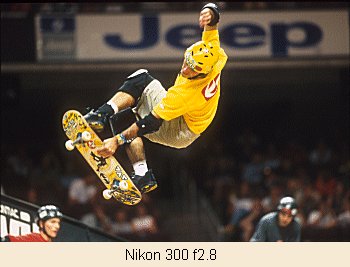
| Nikon 300mm f2.8
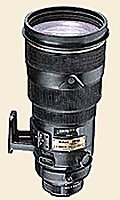
|
At a Glance
Filter Size: 52mm rear filter screw type, gel filter holder
incl.
Lens Hood: Carbon fiber hood incl.
Weight: 5.7 lbs
Dimensions: 10.6"x4.8"
Front Rotate w/Focus: No
Groups/Elements: 8/11
Close Focus: 7.5 feet, manual focus to 7.2 feet
Available Mounts: Nikon only |
| Short: Our favorite lens in this group. Fast and sharp, it
consistently brought home the bacon. Also notable was the best
designed case of the bunch. |
| Tokina 300mm f2.8

|
At a Glance
Filter Size: 112mm front and 35.5mm rear drop in.
Lens Hood: included
Weight: 5 lbs
Dimensions: 8.4"x4.6"
Front Rotate w/Focus: No
Groups/Elements: 7/9
Close Focus: 7.9'
Available Mounts: Nikon, Canon, Minolta, and Pentax |
| Short: Comfortable to shot with, second fastest after the Nikon at
half the price. Focus speed is fast enough that it's easy to get
your timing dialed in for action sports. Light fall-off when wide
open would be a problem with some types of photography, such as bird
photography, where the continuous blue tones would make it obvious.
Priced attractively at less than half the price of the Nikon and Minolta
lenses. |
| Minolta 300mm
f2.8
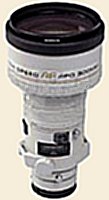
|
At a Glance
Filter Size: 42mm rear drop in
Lens Hood: Quick hood part of lens
Weight: 5lbs 7.5oz
Dimensions: 9.5"x5"
Front Rotate w/Focus: No
Groups/Elements: 9/11
Close Focus: 8.2'
Available Mounts: Minolta only |
| Short: Slowest focus speed makes it the worst choice in this group
for action sports but it's rugged design and tack sharp images make it a
good choice for many types of outdoor and wildlife photography.
This lens also features an ingenious hood design that saves the
awkward dance we had to do with the others. |
| Sigma 300mm f2.8

|
At a Glance
Filter Size: 46mm rear drop in
Lens Hood: included
Weight: 5lbs 4.7oz
Dimensions: 8.3"x4.7"
Front Rotate w/Focus: No
Groups/Elements: 9/11
Close Focus: 8.2'
Available Mounts: Nikon, Canon, Minolta, Pentax, Sigma-SA |
| Short: The most comfortable to hand hold, this lens has a good
balance and feel. Not our first choice for action sports, but it's
slow focus speed and sharp images make it a good choice for many types
of outdoor photography. Priced attractively at less than half the
price of the Nikon and Minolta lenses. |
Special thanks to our photo assistant Brian Marquardt who hauled
around several complete camera systems plus the considerable weight of
these four lenses and kept copious shooting records for two fast moving
photographers.
 Subscribe to
Vivid Light
Subscribe to
Vivid Light
Photography by email
|
|





|

